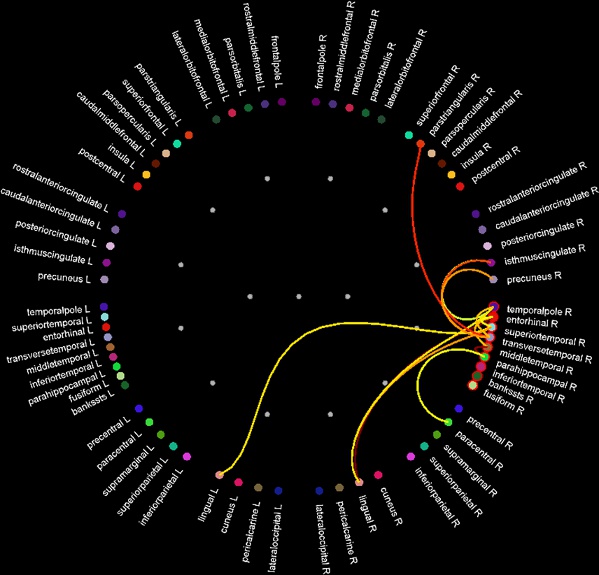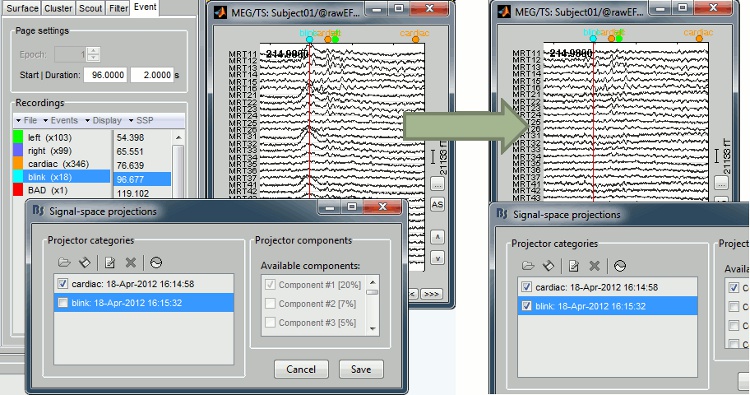|
Size: 6778
Comment:
|
Size: 5267
Comment:
|
| Deletions are marked like this. | Additions are marked like this. |
| Line 1: | Line 1: |
| = Screenshots = <<TableOfContents>> |
= Gallery = == Demo video == Tadel F & Baillet S, March 2015<<BR>>Brainstorm: Imaging neural activity at the speed of brain |
| Line 4: | Line 5: |
| == MEG Auditory evoked potential == Acquisition system: ''Neuromag Vectorview306''. |
<<HTML(<iframe id="ytplayer" type="text/html" width="640" height="360" src="httpz://www.youtube.com/embed/30eFJUrRcN4?autoplay=1&origin=httpz://http://neuroimage.usc.edu/brainstorm" frameborder="0"></iframe>)>> |
| Line 7: | Line 7: |
| Description of the windows: | <<HTML(<!-- video width="853" height="480" controls><source src="httpz://neuroimage.usc.edu/videos/201503_brainstorm_demo.mp4" type="video/mp4"><source src="httpz://neuroimage.usc.edu/videos/201503_brainstorm_demo.ogg" type="video/ogg">Your browser does not support the video tag.</video -->)>> |
| Line 9: | Line 9: |
| * Main Brainstorm window * Timeseries of all the MEG sensors [-200ms, 500ms] * Magnetic field recorded by the magnetometers at t=106ms * Spatial view of the magnetometers time series [-200ms, 500ms] * Reconstruction of the cortical currents, based on the magnetometers, at t=106ms |
== MEG somatosensory evoked responses == Acquisition on a ''CTF 275'' instrument for a left median nerve electric stimulation. <<BR>>[[attachment:snap_median.jpg|{{attachment:snap_median_sm.jpg|attachment:snap_median.jpg}}]] |
| Line 15: | Line 12: |
| [[attachment:snap_1condition.jpg|{{attachment:snap_1condition_sm.jpg|attachment:snap_1condition.jpg}}]] | == Baby auditory EEG responses == Acquisition system: ''EGI GSN - Baby 64 electrodes''. <<BR>> [[attachment:snap_3conditions.jpg|{{attachment:snap_3conditions_sm.jpg|attachment:snap_3conditions.jpg}}]] |
| Line 17: | Line 15: |
| <<BR>> | == Continuous recordings and markers == Review recordings directly reading from the original files, edit markers, detect and correct artifacts. <<BR>> [[attachment:snap_raw.jpg|{{attachment:snap_raw_sm.jpg|attachment:snap_raw.jpg}}]] |
| Line 19: | Line 18: |
| == Database and right click == The tree in the main Brainstorm window represents the database for the selected study. This database has three levels of definition: Protocol (ie. study, selected in the toolbar), Subject, and Condition. Almost all the operations that can be performed on a file are accessible from the popup menu which is displayed by right clicking on the file. |
== Artifact detection and correction with SSP == A fully automated cleaning pipeline for the most common artifacts (power lines, eye blinks, heartbeats) is available in Brainstorm. The ocular and cardiac artifacts are corrected using the [[Tutorials/TutRawSsp|Signal Space Projection]] approach. |
| Line 22: | Line 21: |
| The first three buttons in the toolbar allows the user to switch between different views of the same database: | === Example: Heartbeat === {{attachment:ssp_ecg.jpg}} |
| Line 24: | Line 24: |
| * Anatomy: display the MRI and surfaces for each subject * Functional data (sorted by subject): sensors definition, recordings, sources, statistic results * Functional data (sorted by condition): idem, but sorted in a different way The following example shows the MEG+EEG protocol "''Catching''", sorted by conditions. There are two experimental conditions, ''Catch ''and ''!NoCatch'', and seven subjects per condition. The popup menu shows all the actions that are available for the recordings of subject ''cc'', condition ''Catch''. [[attachment:snap_rightclick.jpg|{{attachment:snap_rightclick_sm.jpg|attachment:snap_rightclick.jpg}}]] <<BR>> == Multiple conditions: Baby auditory EEG == Acquisition system: ''EGI GSN - Baby 64 electrodes'' Description: * One subject: "001" * Three conditions: "GM", "GMM", "VM" * Two views: overlaid electrodes time series, and estimated cortical sources at t=376ms [[attachment:snap_3conditions.jpg|{{attachment:snap_3conditions_sm.jpg|attachment:snap_3conditions.jpg}}]] <<BR>> |
=== Example: Eye blink === [[attachment:sspExample.gif|{{attachment:sspExample_sm.jpg|attachment:sspExample.gif}}]] |
| Line 48: | Line 28: |
| Brainstorm offers the possibility to reconstruct the cortical activity either on the individual subject anatomy, or on a default anatomy (MNI / Colin27). For this purpose, many interactive tools are available to view, register and process the MR images and the corresponding meshes. However, the cortex segmentation must be performed by an external program of your choice ([[Links|list here]]). | Brainstorm features the possibility to model MEG and EEG neural generators either from the individual subject anatomy, or by using a template anatomy (MNI / Colin27) that can be warped to the individual scalp surface. Multiple interactive tools are available to view, register and process the MR images and the corresponding tessellated envelopes. However, tissue segmentation must be performed using another software; multiple options exist today in the academic community ([[Tutorials/LabelFreeSurfer|FreeSurfer]], [[Tutorials/SegBrainSuite|BrainSuite]], [[Tutorials/SegBrainVisa|BrainVISA]], [[Tutorials/SegCIVET|CIVET]]). |
| Line 50: | Line 30: |
| Here are a few examples of the views you can obtain with a simple click on a MRI or a surface. All the 3D views can be rotated freely with the mouse, zoomed with the wheel, edited with the "Surfaces panel" and with their popup menus. The MRI slices can be moved with a simple mouse operation: right-click and mouse drag. [[attachment:snap_anatomy.jpg|{{attachment:snap_anatomy_sm.jpg|attachment:snap_anatomy.jpg}}]] <<BR>> |
We provide a few examples of the views you can easily obtain with Brainstorm. All the 3D views can be rotated freely with the mouse, zoomed with the wheel, edited with the "Surface panel" and contextual popup menus. The MRI slices can be browsed with a simple mouse operation: right-click and mouse drag.<<BR>>[[attachment:snap_anatomy.jpg|{{attachment:snap_anatomy_sm.jpg|attachment:snap_anatomy.jpg}}]] |
| Line 57: | Line 33: |
| All the figures displayed with Brainstorm are always linked in time; and if they represent the same dataset, the sensors selection is also the same for all the views. The selection of a channel is done by clicking on it, in a time series or a 3D view. Selected channels can be displayed separately, marked as "bad", or deleted. | All the figures displayed by Brainstorm are linked in time. If they feature the same dataset, the sensor selection is also the same for all views. The selection of a channel subset can be easily perfomed by clicking on the corresponding channels in a time series display or a 3D view. Selected channels can be displayed separately, marked as "bad", or deleted.<<BR>>[[attachment:snap_channel.jpg|{{attachment:snap_channel_sm.jpg|attachment:snap_channel.jpg}}]] |
| Line 59: | Line 35: |
| [[attachment:snap_channel.jpg|{{attachment:snap_channel_sm.jpg|attachment:snap_channel.jpg}}]] | == Cortical regions of interest == Acquisition system: ''CTF MEG - 275 sensors'' |
| Line 61: | Line 38: |
| <<BR>> | Scouts are cortical regions of interest, defined graphically from the "Scout" tab. They can be used to extract the time series of MEG and EEG generators within a single or mulitlple brain region. |
| Line 63: | Line 40: |
| == Online bandpass filtering == Recordings and sources: 40Hz low-pass filtering with the "Filters" tab in main Brainstorm window. |
The following example shows the cortical response to an electric stimulation of the left median nerve. With the three scouts "S1 right", "S2 right" and "S2 left"'','' we can track the processing of the stimulus in the brain: 1) contralateral primary somatosensory cortex, 2) contralateral secondary somatosensory, 3) ipsilateral secondary somatosensory.<<BR>>[[attachment:snap_1scout.jpg|{{attachment:snap_1scout_sm.jpg|attachment:snap_1scout.jpg}}]] |
| Line 66: | Line 42: |
| {{attachment:snap_online_filter.jpg|attachment:snap_online_filter.jpg}} | == Anatomical atlases == Integrated support for the individual surface-based anatomical atlases generated by FreeSurfer and BrainSuite.<<BR>><<BR>> {{attachment:atlases.jpg||height="358",width="750"}} |
| Line 68: | Line 45: |
| <<BR>> | == Scripting environment == Everything that can be done in the interface with mouse clicks can be automatically converted to Matlab scripts, using the Process1 and Process2 tabs.<<BR>>[[attachment:snap_scripting.jpg|{{attachment:snap_scripting_sm.jpg|attachment:snap_scripting.jpg}}]] |
| Line 70: | Line 48: |
| == Cortical region of interest: Scout == Acquisition system: ''CTF MEG - 151 sensors'' |
== Digitize and co-register == For accurate source localization in MEG and EEG with registration to anatomical MRI image volume and efficient head localization in MEG, a 3D digitization solution such as the Polhemus-Fastrak is required. Brainstorm features an integrated support for driving a Polhemus device that will help you save time and is efficient for error-checking while digitizing sensor positions and the subject's head shape.<<BR>>The digitized points are used to check and/or fix visually the alignment of the MRI/surfaces and the MEG/EEG sensors.<<BR>><<BR>> {{attachment:polhemus.jpg}} |
| Line 73: | Line 51: |
| The ''scouts'' are subsets of the cortical vertices, defined graphically with the "''Scouts''" tab. They are useful to extract the time series of a the electrical activity of one or several brain regions. This example shows the cortical response to an electric stimulation of the left index finger. With the two scouts ''Left ''and ''Right'' we can observe the electrical activity in the primary somatosensory cortex in both hemispheres. [[attachment:snap_1scout.jpg|{{attachment:snap_1scout_sm.jpg|attachment:snap_1scout.jpg}}]] <<BR>> == Scouts: multiple conditions == Acquisition system: ''CTF MEG - 151 sensors'' Same experiment than the previous example, but showing at the same time the responses for condition ''Left-1'' (electric stimulation of the left index) and ''Left-4'' (left ring finger). [[attachment:snap_2scouts.jpg|{{attachment:snap_2scouts_sm.jpg|attachment:snap_2scouts.jpg}}]] <<BR>> == Scouts: multiple conditions == Acquisition system: ''CTF MEG - 151 sensors'' Same experiment, with additional display of the scout activity on the 3D MRI slices. [[attachment:snap_scout3D.jpg|{{attachment:snap_scout3D_sm.jpg|attachment:snap_scout3D.jpg}}]] <<BR>> == Statistical analysis: z-score == Acquisition system: ''EGI GSN - Baby 64 electrodes'' The "''Processes''" tab in the main [[BrainStorm|Brainstorm]] window allows the user to apply several functions to a set of recordings of sources files. Drag and drop files from the database tree to the white box in the "Processes" tab, and click on "''Run''" to process them. The function that was applied here is a z-score statistic. The algorithm is the following. For each channel: * Compute the mean ''m'' and the variance ''v'' for the baseline * For all the time samples: substract ''m'' and divide by ''v'' The top-right figure represents the initial sources estimate, and the bottom-left figure shows the z-score values for those sources. [[attachment:snap_zscore.jpg|{{attachment:snap_zscore_sm.jpg|attachment:snap_zscore.jpg}}]] <<BR>> == Statistical analysis: t-test == Acquisition system: ''EGI GSN - Baby 64 electrodes'' The "''Processes''" tab can also be used for computing statistical tests, to evaluate the differences between two experimental conditions. This example shows the evaluation of the difference between conditions ''GM'' and ''GMM'', using the results of many different subjects (paired Student t-test, p<0.05). The top figure represents the significance of the difference at the electrodes level across the time, and the bottom figure the thresholded t-values at the cortical level at 280ms. This image also illustrates the "''Coordinates''" tab. It is possible to pick any point from any surface by clicking on it, and immediately get its coordinates in all the coordinates systems used by Brainstorm (MRI, Subject's head and Talairach). [[attachment:snap_ttest.jpg|{{attachment:snap_ttest_sm.jpg|attachment:snap_ttest.jpg}}]] <<BR>> |
== Functional connectivity == {{attachment:connect_graph.jpg}} |
Gallery
Demo video
Tadel F & Baillet S, March 2015
Brainstorm: Imaging neural activity at the speed of brain
MEG somatosensory evoked responses
Acquisition on a CTF 275 instrument for a left median nerve electric stimulation.
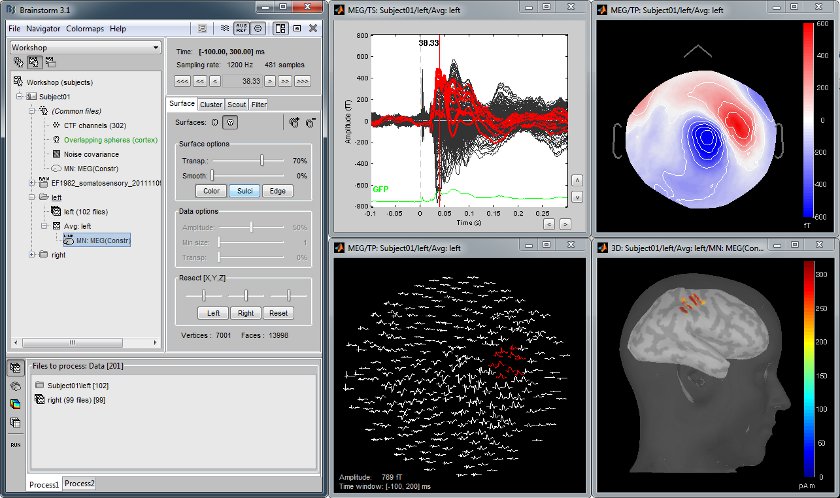
Baby auditory EEG responses
Acquisition system: EGI GSN - Baby 64 electrodes.
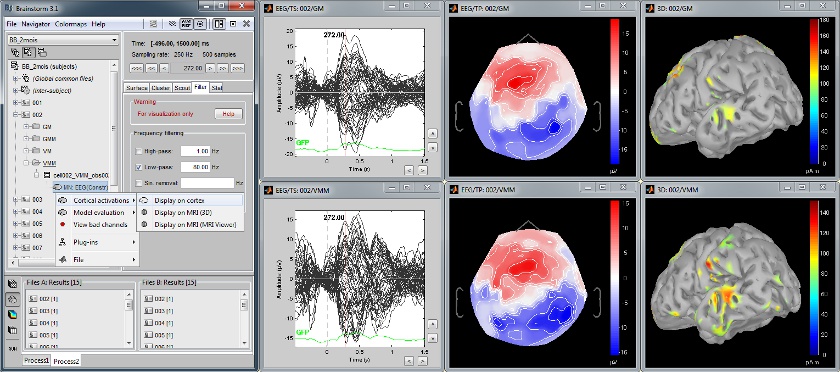
Continuous recordings and markers
Review recordings directly reading from the original files, edit markers, detect and correct artifacts.
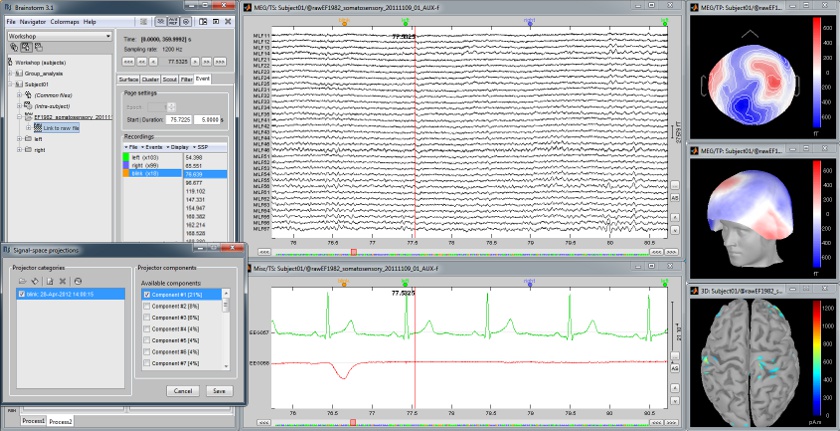
Artifact detection and correction with SSP
A fully automated cleaning pipeline for the most common artifacts (power lines, eye blinks, heartbeats) is available in Brainstorm. The ocular and cardiac artifacts are corrected using the ?Signal Space Projection approach.
Example: Heartbeat
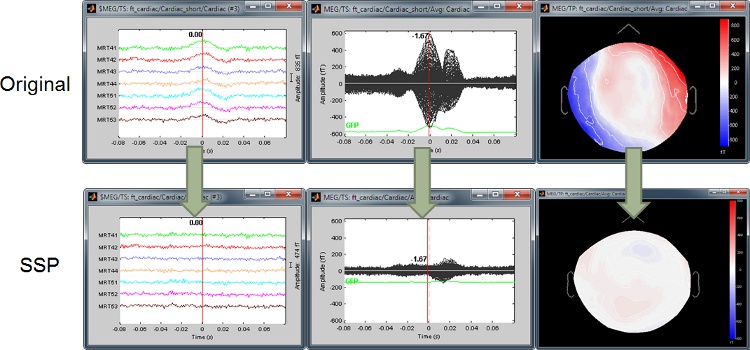
Example: Eye blink
Subject anatomy: MRI and surfaces
Brainstorm features the possibility to model MEG and EEG neural generators either from the individual subject anatomy, or by using a template anatomy (MNI / Colin27) that can be warped to the individual scalp surface. Multiple interactive tools are available to view, register and process the MR images and the corresponding tessellated envelopes. However, tissue segmentation must be performed using another software; multiple options exist today in the academic community (FreeSurfer, BrainSuite, BrainVISA, CIVET).
We provide a few examples of the views you can easily obtain with Brainstorm. All the 3D views can be rotated freely with the mouse, zoomed with the wheel, edited with the "Surface panel" and contextual popup menus. The MRI slices can be browsed with a simple mouse operation: right-click and mouse drag.
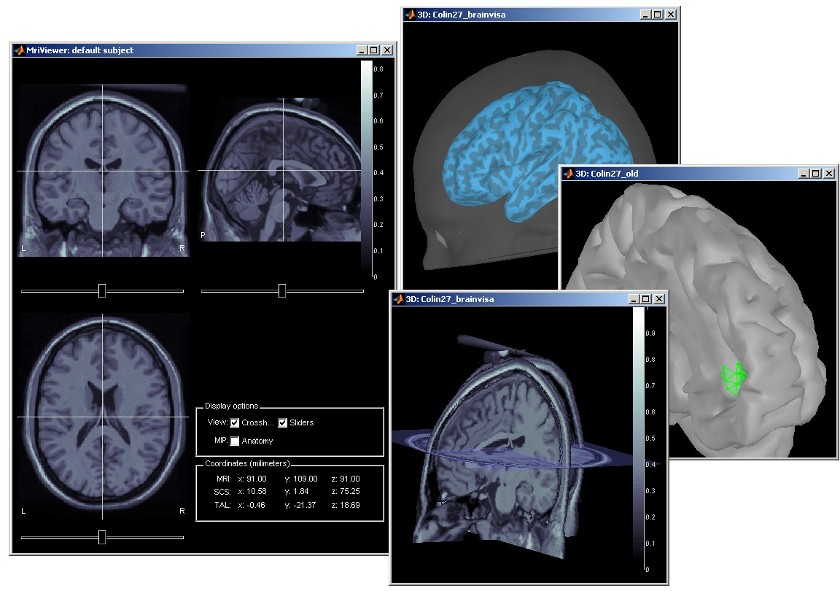
Channel selection
All the figures displayed by Brainstorm are linked in time. If they feature the same dataset, the sensor selection is also the same for all views. The selection of a channel subset can be easily perfomed by clicking on the corresponding channels in a time series display or a 3D view. Selected channels can be displayed separately, marked as "bad", or deleted.
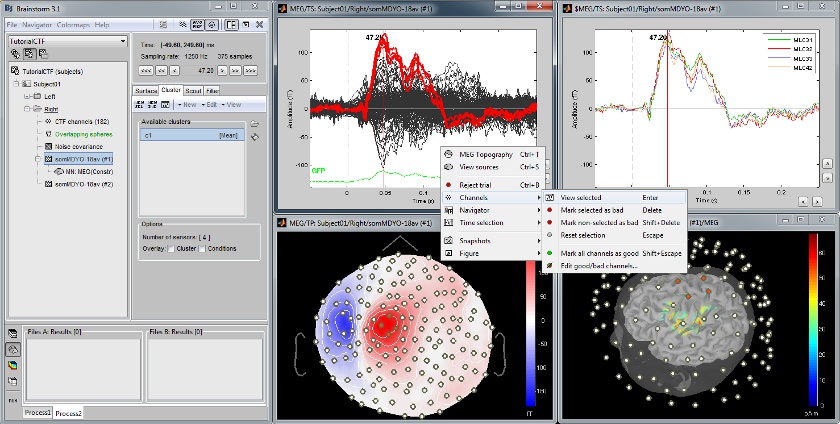
Cortical regions of interest
Acquisition system: CTF MEG - 275 sensors
Scouts are cortical regions of interest, defined graphically from the "Scout" tab. They can be used to extract the time series of MEG and EEG generators within a single or mulitlple brain region.
The following example shows the cortical response to an electric stimulation of the left median nerve. With the three scouts "S1 right", "S2 right" and "S2 left", we can track the processing of the stimulus in the brain: 1) contralateral primary somatosensory cortex, 2) contralateral secondary somatosensory, 3) ipsilateral secondary somatosensory.
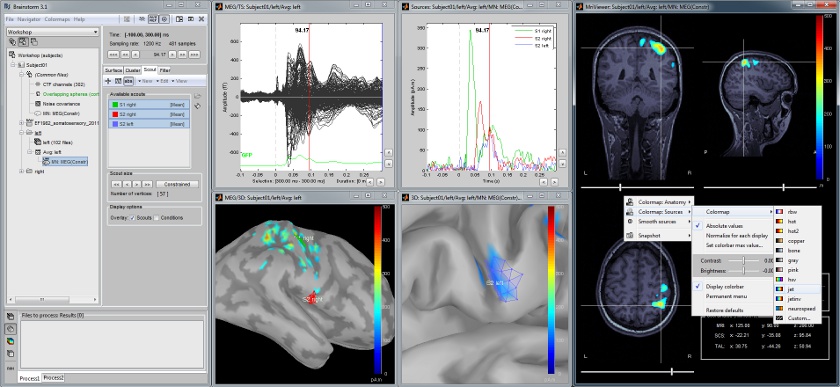
Anatomical atlases
Integrated support for the individual surface-based anatomical atlases generated by FreeSurfer and BrainSuite.
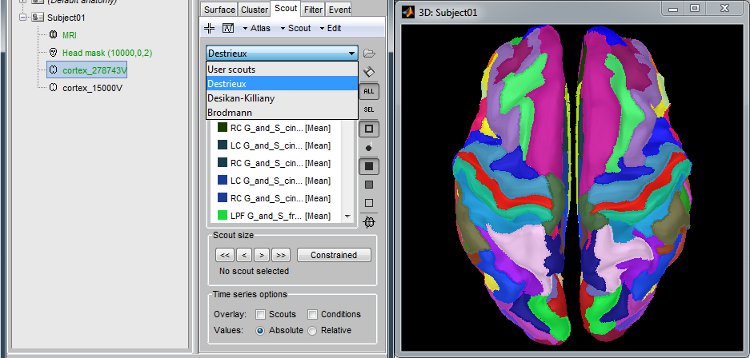
Scripting environment
Everything that can be done in the interface with mouse clicks can be automatically converted to Matlab scripts, using the Process1 and Process2 tabs.
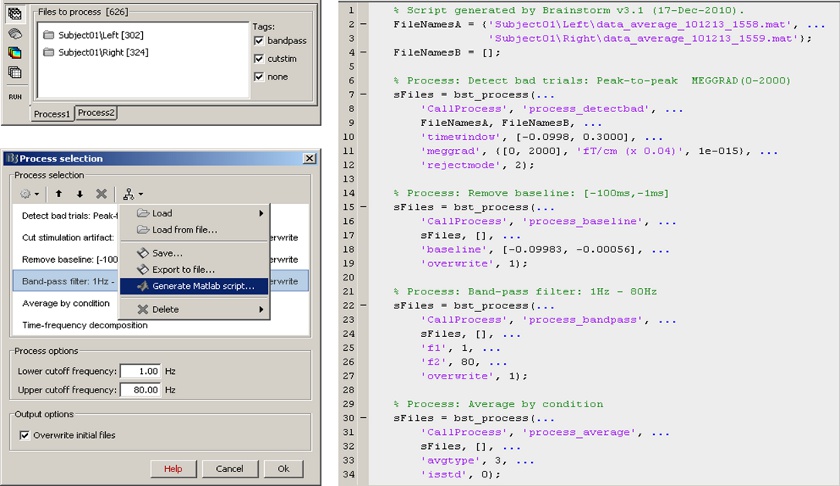
Digitize and co-register
For accurate source localization in MEG and EEG with registration to anatomical MRI image volume and efficient head localization in MEG, a 3D digitization solution such as the Polhemus-Fastrak is required. Brainstorm features an integrated support for driving a Polhemus device that will help you save time and is efficient for error-checking while digitizing sensor positions and the subject's head shape.
The digitized points are used to check and/or fix visually the alignment of the MRI/surfaces and the MEG/EEG sensors.
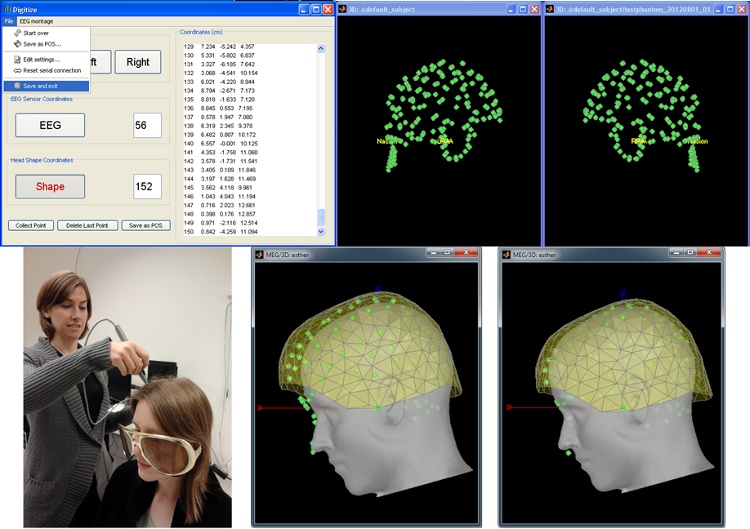
Functional connectivity
